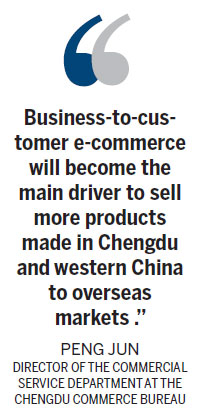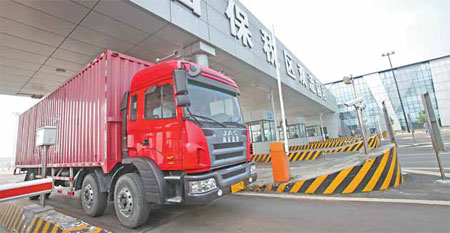E-commerce fuels Chengdu's trade growth
Updated: 2014-05-05 08:19
By Zhong Nan and Li Yu in Chengdu and Lu Haoting in Beijing (China Daily)
|
||||||||
Cross-border platforms expand into multiple industries
With transactions thriving - particularly online - between international markets and China's western region, Chengdu is boosting its logistics services to meet the demand of a red-hot e-commerce boom in the city.
As the capital of southwestern Sichuan province, the city has long been an important commercial center for the domestic market, but such trade is no longer as central to Chengdu as it used to be. The e-commerce companies here are increasingly deploying money and resources into cross-border e-commerce platforms to fuel their growth.
Peng Jun, director of the commercial service department at the Chengdu commerce bureau, says cross-border business has expanded into many different industries, including trade, finance, tourism, agriculture and transportation.
"Business-to-customer e-commerce will become the main driver to sell more products made in Chengdu and western China to overseas markets," Peng says. Chengdu's exports and imports via cross-border e-commerce accounted for approximately 10 percent of the city's total trade volume of $49 billion last year, according to Chengdu's municipal development and reform commission.
With more than 8,000 companies carrying out various e-commerce functions, including supply chain management, mobile commerce, online platforms, Internet marketing and transaction processing, Chengdu generated 550 billion yuan ($88 billion) in business transactions on its e-commerce platforms last year.

Over 40 large e-commerce businesses have set up their regional headquarters, operational hubs, and research and development centers in the city. Chengdu is also home to 150 third-party e-commerce platforms, with nearly 12,000 companies and more than 63,000 employees. The platforms so far have created 380,000 jobs.
As some foreign and domestic manufacturers are moving their production facilities inland to seek new market growth points, Peng says inland regions will continue to gain a market presence from international markets through cross-border e-commerce.
Indeed, an increasing number of eBay sellers are emerging from such inland cities as Chengdu; Zhengzhou, Henan province; and Xi'an, Shaanxi province. Sales on the online auction site from Chengdu rose 38 percent from 2012 to 2013, the Hangzhou-based China e-Business Research Center says.
"To meet the demand for goods transportation to overseas destinations ordered through e-commerce platforms, we are making plans to strengthen the city's ability for logistics services, from rail to air," Peng says.
Chengdu also is expecting that an express rail route that opened in April 2013, linking Chengdu and Lodz, Poland, will operate bi-directional service this year. The international rail hub in Chengdu will assist Chinese cross-border e-commerce companies in buying more European goods and selling them back to the domestic market.
The route currently departs Chengdu for Lodz every Saturday with 41 standard containers on each train. Its cargo mostly includes IT products, auto parts, home appliances, clothing and shoes, as well as daily necessities, mostly produced in Chengdu.
Chen Zhongwei, director of the Chengdu logistics office, says Chengdu's cross-border e-commerce companies will be the biggest beneficiaries from this rail route, as they won't need to send their goods to port cities any longer and wait for months for the arrival of shipments in Europe. The rail line "reversed the concept that an export-oriented economy must rely on seaports, turning Chengdu's inland geographical disadvantage into an advantage for exporting to Europe".
After arriving in Poland, Chinese goods can be distributed to markets throughout Europe, such as Germany, France and the Netherlands, within one to three days. The express rail is a month faster than ocean shipping and costs only a quarter of air cargo transportation. A single trip currently takes 12 to 14 days.
DHL Global Forwarding also is finding Chengdu's cross-border e-commerce platform for high-end goods, such as pharmaceutical, food and chemical products, to be another attractive use for this rail route. In January, the German company introduced its first temperature-controlled China-Europe rail service between Chengdu and Lodz.
"This service will provide a flexible shipping solution for temperature-sensitive European products, such as German drugs and vaccines, Dutch dairy products, French wine and processed Spanish agricultural products, to China, after the bi-directional rail service becomes operational," says Hou Hanping, a professor of logistics management at Beijing Jiaotong University. "These goods previously were unable to use the fast and cost-effective transcontinental west rail corridor, especially during winter and summer."
The central government offered incentives to encourage the development of cross-border e-commerce in January this year. Companies can enjoy a refund or tax-free policies for consumption and valued-added taxes.
Eager to develop more overseas markets, Chengdu plans to open three more international air routes - to San Francisco, Moscow and Sri Lanka - this year, and make flights to Europe, the Middle East and other Asian countries more frequent. The city is also working on a second airport to ease air traffic congestion and enlarge the space and facilities for air cargo. With a budget of 54.5 billion yuan, construction work is set to begin next year.
Contact the writers through zhongnan@chinadaily.com.cn.
|
A truck carries exported goods through a duty-free zone in Chengdu. The capital city of southwestern Sichuan province is making an effort to promote its foreign trade via e-commerce platforms. Provided to China Daily |
(China Daily USA 05/05/2014 page16)

 Chinese: Parking rules 'unfair'
Chinese: Parking rules 'unfair'
 Demand for bilingual guides on the rise
Demand for bilingual guides on the rise
 Banks using HK as RMB trade center
Banks using HK as RMB trade center
 Houston tries shuttlecock diplomacy
Houston tries shuttlecock diplomacy
 Obama roasts himself, rivals at dinner
Obama roasts himself, rivals at dinner
 H&M promotes summer collections with DJ show in NYC
H&M promotes summer collections with DJ show in NYC
 Forum trends: No house, no marriage?
Forum trends: No house, no marriage?
 One handed climber scales UK's toughest routes
One handed climber scales UK's toughest routes
Most Viewed
Editor's Picks

|

|

|

|

|

|
Today's Top News
Academic lauds US-China partnerships
Chinese premier proposes to upgrade China-Africa cooperation in six areas
E-commerce fuels Chengdu's trade growth
Prospects brighter for foreign banks in China
Travel passes to DPRK made easier
Fast fashion gets sustainable
Yunnan's only panda perking up thanks to TV
Intl cooperation to aid drug fight
US Weekly

|

|








